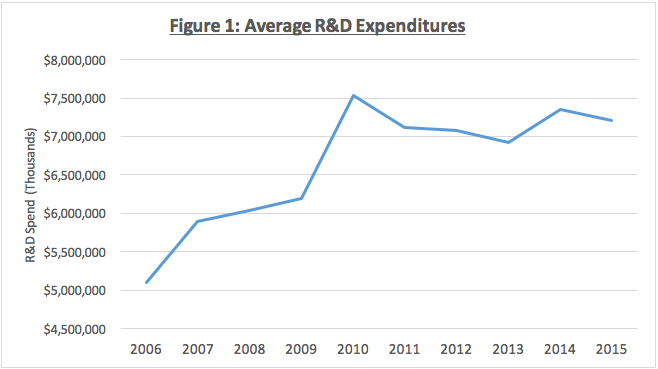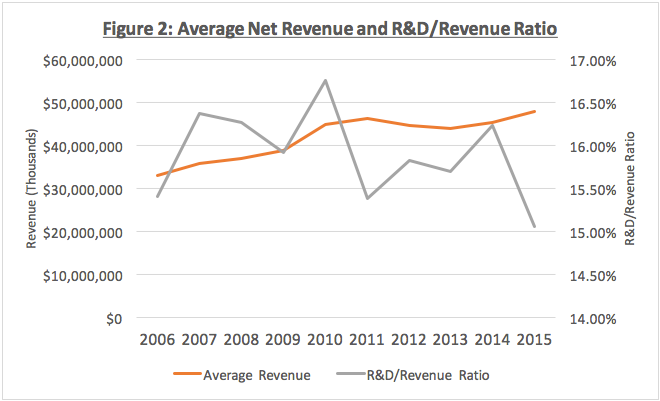Will Another Recession Bash the Biopharmaceutical Industry?
Some in the financial industry have argued that we may be in the midst of another economic recession. The biopharmaceutical industry has shown resiliency during such times and industry trends point to that being the case again.
Skeptics in the financial industry are starting to question continued macroeconomic growth, and are arguing that we might be at the brink of another recession. While, in March of 2016, the US unemployment rate dropped to 5%, corporate profits are starting to decline 1, industrial production is showing signs of deterioration, as the capacity utilization rate has dropped to 75% 2, and the stock market doesn’t appear to be growing. Naturally, with recessions come risks associated with corporate growth and losing our jobs, however, the biopharmaceutical industry has been quite resilient during recessions. In this article, we will analyze biopharmaceutical industry trends, and how another recession may impact the industry. Recent Risk Reduction Strategies in Biopharmaceuticals Due to high failure rates associated with drug development, biopharmaceutical enterprises are attempting new risk reduction strategies, such as externalization, or sharing the development of new molecules in collaboration with other biopharmaceutical enterprises, and implementing corporate venture programs that seek to acquire molecules in development 3.
Moe Alsumidaie

Another activity that has been driven by the recent macroeconomic changes (such as low interest rates on debt) is M&A. M&A in healthcare has hit a record high of $724 billion in 2015, up 66% since 2014, and deal activity has doubled in the last year 5. M&A also comes with interesting financial behavior in R&D. To elaborate, during the first four years after an acquisition, a biopharmaceutical company experiences a decline in R&D spend, however, R&D spend ramps up after that period (due to reorganization, and allocating more resources towards commercializing acquired medical products in development) 6. Impact of Negative Interest Rates on Biopharmaceuticals During the 2008 great recession the Fed lowered interest rates, and implemented bond buying programs (quantitative easing, or QE) in hopes to increase economic monetary supply, and it worked, as money supply surged to record highs, bringing the US out of a recession 7, and raising consumer spending 8. However, Japan and the European Central Bank attempted to implement similar programs, but, failed; both economies are still struggling 9, 10. In other words, European and Japanese banks were accessing low interest capital, but, were not lending it because they felt that holding on to the capital was less risky than lending or investing it. Correspondingly, financial authorities are currently implementing negative interest rates in order to force economic growth, lending and risk-taking. This strategy, in essence, charges banks and consumers for holding on to cash in their bank accounts. The start-up biopharmaceutical industry has experienced an unprecedented influx of venture capital investments over the past several years, reaching a record high of $16 billion in 2015 11; near-zero interest rates most likely attributed towards an increase in investments. While, according to financial experts, implementing negative interest rates is still considered an unproven economic experiment, in theory, this model can stimulate even more investment in biopharmaceutical start-ups. How the 2008 Recession Impacted Big Pharma The biopharmaceutical industry seemed unfazed by the 2008 recession. Figure 1 outlines average R&D spend from 7 of the largest biopharmaceutical enterprises (Roche, AstraZeneca, Gilead, JnJ, Merck, Novartis, and Pfizer), and demonstrates that average R&D spending increased by 25% from 2008-2010.

Though Figure 2 demonstrates that revenue growth increased by 21% from 2008-2010, the industry experienced slightly negative growth from 2011-2013. However, profitability soared, as net income rose by 28% from $8.4 billion in 2008 to $10.8 billion in 2015. Moreover, a declining R&D/Revenue ratio is indicative of healthy relative growth, despite macroeconomic challenges.

What Could Happen If Another Recession Hits? This analysis has demonstrated that the biopharmaceutical industry is quite resilient to recessions. Moreover, engaging in risk-sharing and M&A strategies will continue to stimulate R&D spending and innovations in healthcare. Should another recession hit, it is likely that even the US may implement negative interest rates. While this measure is still an experiment in the EU and Japan, in theory, negative interest rates should stimulate more investments into novel therapeutics. It is possible that we will start seeing an influx of startup biopharmaceutical companies, and additional M&A. For resources in R&D, it is likely that, with M&A, there will be a lot of job shifts and reorganizations. However, overall capital spending (and opportunities) in R&D will likely remain stable.
References:
- http://www.tradingeconomics.com/united-states/corporate-profits
- http://www.tradingeconomics.com/united-states/capacity-utilization
- http://www.mckinsey.com/industries/pharmaceuticals-and-medical-products/our-insights/new-frontiers-in-pharma-r-and-38d-investment
- http://fortune.com/2015/07/28/why-pharma-mergers-are-booming/
- https://next.ft.com/content/9adbce94-c902-11e5-be0b-b7ece4e953a0
- Getz, Zuckerman, DiMasi, Kaitin, Drug Development Portfolio and Spending Practices After Mergers and Acquisitions, Drug information Journal Vol 43, 2009
- http://www.tradingeconomics.com/united-states/money-supply-m0
- http://www.tradingeconomics.com/united-states/consumer-spending
- http://www.tradingeconomics.com/euro-area/consumer-spending
- http://www.tradingeconomics.com/japan/consumer-spending
- http://blogs.wsj.com/venturecapital/2016/01/25/the-daily-startup-health-care-venture-investment-sets-records-in-2015/